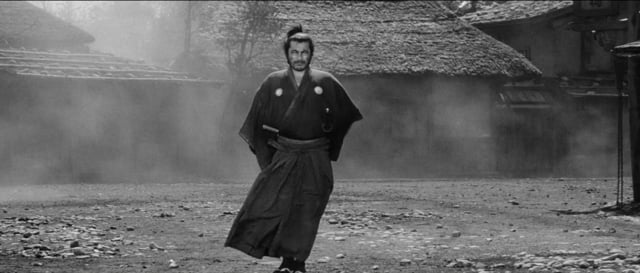I recently watched an excellent short analysis of some of director Akira Kurosawa’s film-making techniques by Tony Zhou, and it got me thinking about how we prose writers could apply some of Kurosawa’s techniques to our own work.
So, before we begin, take the time to enjoy Tony’s short 8-minute video. It’s well done, and just watching it makes me want to run out and watch all of Kurosawa’s films just for their sheer artistry and beauty…
Akira Kurosawa – Composing Movement from Tony Zhou on Vimeo.
Okay, now you’re up to speed, let’s talk about how some of his key ideas can be applied to writing.
Now, my first takeaway from Kurosawa is the obvious one- nothing in a story should be wasted. Everything down to the last period should be in a story for a reason, and should be working to make that story into the best possible story you can make it. Since as a writer you have absolute control over what’s on that page, and what your reader perceives, you can control what they see much like a camera does, and like Kurosawa you should be using every tool at your disposal to bring your story to life with the greatest effect.
Let’s look at a few specifics:
The Environment
One of the first things Zhou discusses is Kurosawa’s masterful use of the environment- Kurosawa uses it to create both visual stimulation and to show the mental states of characters. While it might be trickier for we prose writers to use the environment to create direct visual stimulation, it’s definitely a good reminder that we shouldn’t underestimate the power of weaving the environment into our writing. It’s very easy to write everything as happening during sunny days and breezy evenings, but aren’t you missing an opportunity if you do so? Think about what environmental conditions could help to push your scene or theme to the next level, and weave them into the story in a way which supports and reinforces the story in some way. Whether it’s swirling fog to represent a character’s confusion, or a distant blazing forest fire that progressively fills the character’s world with smoke and indicates looming trouble, it can only make your story stronger.
Groups
Dealing with groups of people might seem a more visual element than a prose one, but it can still be useful for writers to consider. It’s very easy to picture characters doing things alone or with only the other main characters, but having groups of other people around can help to remind the reader that characters do have a place in society. As with the image of the showgirl crying while the other actresses rush past her from Kurosawa’s Stray Dog (1949), how groups of people react to a character can very much represent a character’s inner life as well as their greater place in society.
Key Gestures
Kurosawa liked to have each actor take on a unique gesture or way of moving so that the audience would instantly recognize him or her. This isn’t a bad tip for writers in general, either. Just as you can use visual cues like clothing, accessories or appearance to bring your characters to life in the reader’s imaginations, you can use gestures and movement as well. If you give each of the central characters a motion they consciously or unconsciously perform on a regular basis, it acts as another layer of characterization and something to play with. Of course, the gesture shouldn’t be overdone or comical (unless that’s your goal), but if subtly worked in it could reflect a lot about the character and their inner life.
Movement
There are many ways to look at movement and how it could benefit writing prose. The most direct one would be to try to have your characters doing actions or activities in their scenes, which both make the scene a little more lively (avoiding a “staged” feeling) and allows for a lot of subtext where you connect the actions with the inner life of the characters or themes playing out. I can’t recall who it was, but there was a famous author who said that they always started scenes with characters in motion in some way and finished in similar form.
Of course, movement can also be played out with the “camera” of the descriptive prose itself. Looking at description as a camera and thinking through the effects that different “shots” would have like a cinematographer could definitely benefit your writing in subtle ways. For example, did you know that each of the standard camera shots (close up, medium shot, long shot, worm’s eye view, etc) actually have a psychological or emotional effect on how the viewer interprets the character and scene? There is a whole language to film that’s developed over a hundred years and that we learn as children on a subconscious level. Learning the different shots and why directors use them could benefit your writing by letting you tap into that treasure trove of audience psychology.
Regardless of what you decide to use (or not use) from Kurosawa’s approach, thinking through your approach to scenes in a visual or cinematic way can only enhance your final work. However, do remember that the power of prose over video is that it can go deep inside characters and to places that video can’t, and you should be taking advantage of not just the visual and audio, but also the other senses in your scenes as well.
Rob
P.S. Check out Tony Zhou’s other videos, they’re really something else and will give you a new appreciation of the power of film.



Motion usually catches my attention, but it is always secondary. The thing that i Iook for first are the people. Nonetheless, he does make a few good points that may be applied to almost any storytelling medium*. As he says, Kurosawa became a grandmaster because he worked on all of the elements of film, not just motion.
* with the possible exception of Twine stories, because the places created using that piece of software are mostly static, and other elements of movement are very limited
He did indeed. I actually watched a Kurosawa film (Stray Dog) this weekend, and I have to say that knowing the “tricks” Kurosawa was using just made the experience twice as amazing. He really was a master of all elements of film, and watching him in action almost makes me want to take up film-making myself, because it’s just that beautiful to see.